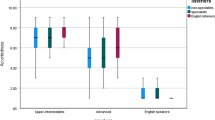Abstract
‘Foreign accent’ is a term popularly used to refer to the characteristics of L2 speech that make it noticeably different from that of native speakers of a particular community (Munro, Derwing and Sato, 2006). Foreign accent can be defined as ‘non-pathological speech produced by second language learners that differs in partially systematic ways from the speech characteristics of native speakers of a given dialect’ (Southwood and Flege, 1999, p. 335). Munro and Derwing (1999/1995) define accentedness as a listener’s perception of how different a speaker’s accent is from that of the L1 community. It should be noted that, while a ‘foreign accent’ can result in what come across as mispronunciations in many cases, it is not necessarily always the case. As an example, if a Spanish speaker pronounces unaspirated /p/, /t/ or /k/ sounds where a native English speaker would aspirate, this might be noticed by a listener, but not processed as a blatant mispronunciation.
Access this chapter
Tax calculation will be finalised at checkout
Purchases are for personal use only
Preview
Unable to display preview. Download preview PDF.
Similar content being viewed by others
References
Boyd, S. (2003). Foreign-born teachers in a multilingual classroom in Sweden: The role of attitudes to foreign accent. International Journal of Bilingual Education and Bilingualism, 6 (3): 283–95.
Bresnahan, M., Ohashi, R. and Nebashi, R. (2002). Attitudinal and affective response toward accented English. Language and Communication, 22 (6): 171–85.
Derwing, T. and Munro, M. (1997). Accent, intelligibility, and comprehensibility. Studies in Second Language Acquisition, 19 (1): 1–16.
Derwing, T., Munro, M. and Wiebe, G. (1998). Evidence in favor of a broad framework for pronunciation instruction. Language Learning, 48 (3): 393–410.
Eisenstein, M. (1983). Native reactions to non-native speech: A review of empirical research. Studies in Second Language Acquisition, 5: 160–76.
Gynan, N. S. (1985). Comprehension, irritation and error hierarchies. Hispania, 68: 160–5.
Hayes-Harb, R. (2014). Acoustic-phonetic parameters in the perception of accent. In J. M. Levis and A. Moyer (eds), Social dynamics in second language accent (pp. 31–52). Berlin, Germany: Walter de Gruyter.
Johnson, R. and Jenks, F. (1994, March). Native speaker’s perceptions of nonnative speakers: Related to phonetic errors. Paper presented at the annual meeting of the Teachers of English to Speakers of Other Languages, Baltimore, Md.
Lev-Ari, S. and Keysar, B. (2010). Why don t we believe non-native speakers? The influence of accent on credibility. Journal of Experimental Social Psychology, 46 (6): 1093–6.
Lindemann, S. (2005). Who speaks ‘broken English’? US undergraduates’ perceptions of non-native English. International Journal of Applied Linguistics, 15 (2): 187–212.
McNerney, M. and Mendelsohn, D. (1992). Suprasegmentals in the pronunciation class: Setting priorities. In P. Avery and S. Ehrlich (eds), Teaching American English pronunciation (pp. 185–96). Oxford, UK: Oxford University Press.
Major, R. C., Fitzmaurice, S. F., Bunta, F. and Balasubramanian, C. (2002). The effects of nonnative accents on listening comprehension: Implications for ESL assessment. TESOL Quarterly, 36 (2): 173–90.
Matsuda, M. J. (1991). Voices of America: Accent, antidiscrimination law, and a jurisprudence for the last reconstruction. The Yale Law Journal, 100 (5): 1329–407.
Meier, P. and Muller, S. M. (1998). IDEA: International Dialects of English Archive. [online] Available from: http://www.dialectsarchive.com
Morley, J. (1991). The pronunciation component in teaching English to speakers of other languages. TESOL Quarterly, 25 (3): 481–520.
Moyer, A. (2014). The social nature of L2 pronunication. In J. M. Levis and A. Moyer (eds), Social dynamics in second language accent (pp. 11–30). Berlin, Germany: Walter de Gruyter.
Munro, M. and Derwing, T. (1999/1995). Foreign accent, comprehensibility, and intelligibility in the speech of second language learners. Article reprinted in Language Learning, 49, Suppl. 1: 285–310.
Munro, M. and Derwing, T. (1995). Language Learning, 45 (1): 73–97.]
Munro, M. and Derwing, T. (2006). The functional load principle in ESL pronunciation instruction: An exploratory study. System, 34 (4): 520–31.
Munro, M. J., Derwing, T. M. and Sato, K. (2006). Salient accents, covert attitudes: Consciousness-raising for pre-service second language teachers. Prospect: An Australian Journal of TESOL, 21: 67–79.
Pennington, M. and Richards, J. (1986). Pronunciation revisited. TESOL Quarterly, 20 (2): 207–25.
Pickering, L. (2006). Current research on intelligibility in English as a lingua franca. Annual Review of Applied Linguistics, 26: 219–33.
Rubin, D. and Smith, K. (1990). Effects of accent, ethnicity, and lecture topic on undergraduates’ perceptions of nonnative English-speaking teaching assistants. International Journal of Intercultural Relations, 14: 337–53.
Smith, L. and Nelson, C. (1985). International intelligibility of English: Directions and resources. World Englishes, 4: 333–42.
Southwood, M. H. and Flege, J. (1999). Scaling foreign accent: Direct magnitude estimation versus interval scaling. Clinical Linguistics and Phonetics, 13 (5): 335–49.
Varonis, E. and Gass, S. (1982). The comprehensibility of nonnative speech. Studies in Second Language Acquisition, 4 (2): 114–36.
White, L. (2007). Linguistic theory, universal grammar, and second language acquisition. In B. VanPatten and J. Williams (eds), Theories in second language acquisition (pp. 37–56). Mahweh, NJ: Lawrence Erlbaum.
Yager, K. (1992, August). What is native-like L2 pronunciation, anyway? Paper presented at the Annual Meeting of the American Association of Teachers of Spanish and Portuguese, Cancún, Mexico.
Author information
Authors and Affiliations
Editor information
Editors and Affiliations
Copyright information
© 2015 Alan S. Kennedy
About this chapter
Cite this chapter
Kennedy, A.S. (2015). Non-Native Accent and Listener Perceptions of Grammaticality. In: Mompean, J.A., Fouz-González, J. (eds) Investigating English Pronunciation. Palgrave Macmillan, London. https://doi.org/10.1057/9781137509437_6
Download citation
DOI: https://doi.org/10.1057/9781137509437_6
Publisher Name: Palgrave Macmillan, London
Print ISBN: 978-1-137-50942-0
Online ISBN: 978-1-137-50943-7
eBook Packages: Palgrave Education CollectionEducation (R0)




